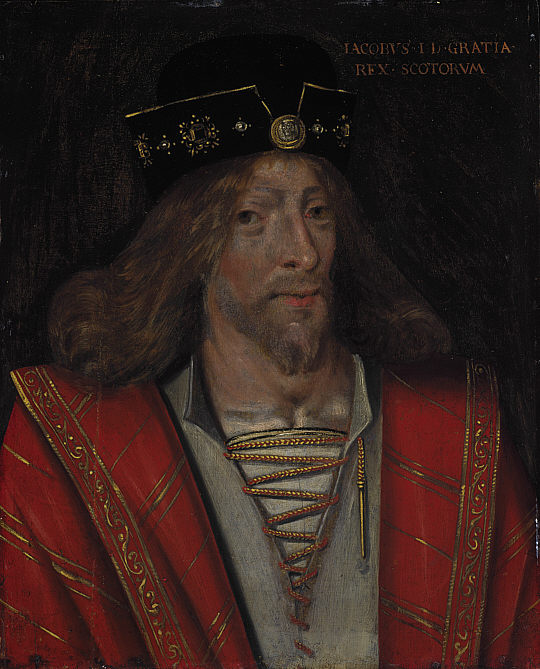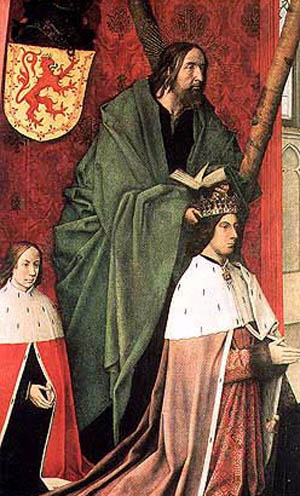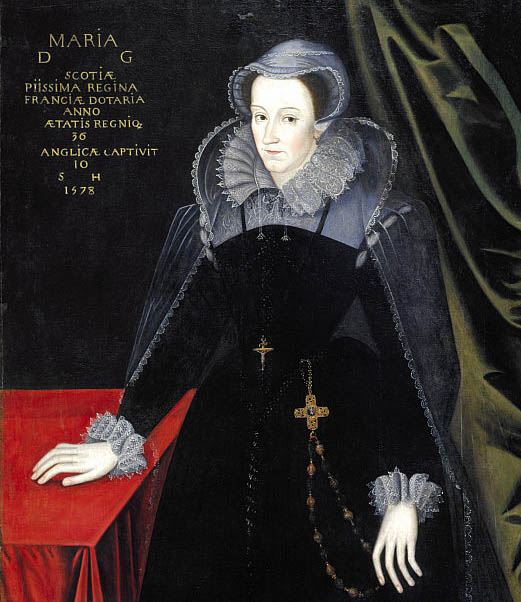Scottish Kings and Queens - Robert II to Mary Queen of Scots.
House of Stewart (1371-1567)
1371-89 Robert II
THE son of Walter, sixth High Steward of Scotland, and Princess Marjorie Bruce, daughter of Robert I, King Robert II had shared in the Regency during his brother David II's exile, but was aged fifty five when he eventually ascended the Scottish throne. He married first, Elizabeth Mure of Rowallan, who had previously been his mistress, then, following her death, Euphemia, daughter of the Earl of Ross. Suspicions relating to the legitimacy of his first marriage would later cause serious disruptions among his descendants.
1390-1406 Robert III
THE eldest son of Robert II by Elizabeth Mure, there were those who claimed that his parents' first marriage was not legitimised, forcing them to have a second formal ceremony. He was baptised John, Earl of Carrick, but assumed the name of Robert when he ascended the throne. In 1367, he had married Annabella Drummond, daughter of Sir John Drummond of Stobhall. Ineffectual as an administrator, he increasingly allowed his brother Robert Stewart, Duke of Albany to assume control despite his having appointed his eldest son David, Duke of Rothesay, Lieutenant of the Kingdom. Rothesay and his uncle Albany had differing ideas as to how the country should be governed and in March 1402, David was found dead at Falkland Palace. The circumstances were suspicious and led his father to send his younger brother James initially to Direleton Castle for protection, then to France, whereupon the boat was intercepted by the English and James taken into custody.
When Robert was told of his son's capture, he sank into a deep depression and, it is said , died of grief. He was buried at Paisley Abbey, considering himself a failure as a king.
 |
James I, Oil on panel, Unknown artist |
JAMES I, the second son of Robert III, was sent to France at the age of twelve for safety, but was captured in-transit and held in England until 1424, twenty years after his father's death. Having married Joan Beaufort, a cousin of Henry VI of England, he was allowed to return to Scotland under the terms of the Treaty of London for a ransom of £40,000. He and Joan had eight children. Scotland in the meantime had been ruled by his uncle, Robert Stewart, Duke of Albany, and Robert’s son, Murdoch Stewart, who became duke on his father's death. Four years after his return, however, James had Murdoch and two of his sons executed for conspiring against him. He then proved a strong ruler, but claims over his succession soon re-emerged from descendants of his grandfather's second marriage. In a conspiracy supported by one such claimant, Walter Stewart, Earl of Atholl, he was murdered by Sir Robert Graham in the Royal lodgings of Blackfriars in Perth.
1437-60 James II
BORN a twin at the Palace of Holyroodhouse, his marginally elder brother Alexander died young. James inherited the throne of Scotland at the age of seven, and in 1449 married Marie de Gueldres. They had seven children. From his birth he carried a facial discolourment which earned him the nickname “Fiery Face.” Because of this he chose to avoid ceremony or public occasions and concentrated on acquiring the military skills which were to stand him in good stead for the conflicts ahead of him.
For the first two years of his reign, the power in the land was exercised by his guardian, Archibald, fifth Earl of Douglas, a grandson of Robert III. However, after Douglas's death in 1438, William, Lord Crichton, Sir Alexander Livingston, and James “The Gross” Douglas, Earl of Buchan, took over control. Two years later, the young sixth Earl of Douglas and his younger brother were murdered, despite the ten-year old King's protests, at Edinburgh Castle at an event which became known as the “Black Dinner.” There is some uncertainty as to exactly why this should have taken place, but power politics were at play and, as a consequence, the powerful Douglas earldom passed to James The Gross, great-uncle of the murdered boys, There was no proof, but he was almost certainly implicated in the deed.
In 1452, the King discovered that William, eighth Earl of Douglas, son of James The Gross, whose vast estates stretched across the Scottish borders to Galloway, had made a pact with England and the Lord of the Isles. Douglas was summoned under safe conduct to Stirling Castle, but when the King challenged him to break his bond, he refused. In a fit of fury, the King stabbed him to death and tossed his body out of a window.
Although the action was vindicated by the Scottish parliament, there ensued a civil war led by the ninth Earl of Douglas and his two brothers. This culminated in 1455 with their being defeated at the Battle of Arkinholm in Dumfriesshire, and coincided with the outbreak of the Wars of the Roses in England. Although James had no intention of becoming embroiled in England's civil war, he allied himself to the House of Lancaster and used this as an excuse to reclaim Roxburgh Castle which had been held by English forces since the twelfth century. It was during the action that he was killed by an exploding cannon.
 |
James III, St Andrew behind him, from the Trinity Altar Panels, Hugo van der Goes (d.1482). Oil on panel, 1478 |
JAMES III was nine years old when his father died, and his mother Queen Marie immediately took over command of the siege of Roxburgh Castle, which fell within days. King James III of Scotland was crowned at Kelso Abbey shortly afterwards.
In 1467, the young King was seized by Lord Boyd of Kilmarnock, and his military tutor, Sir Alexander Boyd. The Boyds then arranged a marriage between James and Princess Margaret of Denmark, daughter of King Christian I of Denmark, Norway and Sweden. Norwegian claims in Orkney and Shetland were pledged against the Princess's dowry, and when the agreed sum was not forthcoming, Scotland acquired the Northern Isles, which were formally annexed in 1472.
To strengthen his own position, Lord Boyd's son was betrothed to the King's sister, Princess Mary, but the eighteen year old monarch, remembering his father's example, had Sir Alexander Boyd executed, whereupon Lord Boyd and his son escaped into exile.
King James was a great patron of the arts, commissioning paintings, poetry, architecture, and the design of jewellery. Despite his marriage being by all appearances a happy one, he almost certainly had homosexual tendencies and formed intimate friendships with individuals whom his nobles considered highly inappropriate. His problems were further fuelled by the ambitions of his brothers, Alexander, Duke of Albany, and John, Earl of Mar. Both were arrested under suspicion of treason, and Mar died in prison. Albany, however, escaped to France, then England where Edward IV offered him his support in return for his recognition of the English king as Overlord.
An army under Edward's brother, Richard, Duke of Gloucester, marched on Scotland and took Berwick. James mobilised, but unwisely placed many of his low-born favourites in key positions, which infuriated a group of his nobles. As a result, Archibald, Earl of Angus (to be known thereafter as “Bell-the-Cat”) and a group of noblemen seized six of the King's closest advisers and hanged them from Lauder Bridge in front of James.
Following this, the Royal army retreated to Edinburgh, but when Albany arrived, having received word from the conspirators, he was advised to reconcile himself with his brother and send the English army home.
Unfortunately, James chose to ignore the lesson of Lauder Bridge and continued to promote his favourites, in particular John Ramsay of Balmain, whom he created Lord Bothwell. Once again such influence at Court was resented, and a powerful group of nobles seized the young Prince James in a plot to overthrow his father.
On 11th June, 1488, the King was confronted at Sauchieburn by an impressive army of Scots seemingly led by his son. The Royal army being overwhelmed, he was forced to flee from the battlefield. While escaping, his horse stumbled and he was thrown to the ground. Although rescued, he was shortly afterwards stabbed to death by persons unknown. His son, overcome with remorse and guilt, wore an iron link belt around his waist as penance for the remainder of his life.
1488-1513 James IV
THE sixteen year old James IV was immensely popular with his subjects and remained so throughout his life. Exercising power from the start of his twenty-five year reign, he led Scotland into a golden age by stabilizing the economy and suppressing upstart factions. He placed great emphasis on education and, as a result, studies of literature and medicine flourished. The King, himself, we are informed, spoke no less than eight languages, including Gaelic, and he combined his father's intellectual and artistic enthusiasms with a love of sport. Through shrewd management, Crown Revenues doubled and large sums were spent on armaments and the creation of a powerful fleet to police the Western Isles.
James travelled his realm extensively and a groundswell of affection was built up between King and many of his remoter subjects. In the meantime, Henry VII of England had offered him his daughter's hand in marriage. James had been intending to marry his mistress Margaret Drummond, daughter of John, Lord Drummond, but in 1502, Margaret and her two sisters were found to have been poisoned at Drummond Castle. Nobody was held responsible and James, in a state of shock, agreed to marry Princess Margaret Tudor, who became Queen of Scotland at the age of thirteen. Although it is said that neither party had much enthusiasm for the other, Margaret bore him six children.
However, despite having signed a Treaty of Perpetual Peace with England, James was determined to maintain the “Auld Alliance” with France. When Pope Julius II formed the Holy League with Ferdinand of Spain and England against France, James mustered a great army and in 1513 marched into England. The ensuing Battle of Flodden was a disaster for the Scots. Over a period of two hours, Scotland's finest army was decimated. King James IV himself lay dead among some 9,000 of his subjects. Among them was almost the entire ruling class of the land.
1513- 42 James V
ONCE again a child inherited the Throne of Scotland. James V was seventeen months old when he was crowned in the Chapel Royal, Stirling. His widowed mother was made Guardian under the terms of her husband's Will, but as the sister of Henry VIII of England, and openly recognising her brother as Overlord, it was to the King's cousin, John Stuart, Duke of Albany, hitherto exiled in France, that Scotland turned. Arriving in Scotland in 1515, his appointment coincided with the treaty signed between France and England, including Scotland. Albany then negotiated the Treaty of Rouen by which James V was lined up to marry a daughter of King Francis I of France. She died in 1537, and James then married Mary de Guise, daughter of Claude, Duke de Guise.
With these French alliances, it was inevitable that James should find himself at odds with his uncle Henry VIII, whom he refused to meet at York in 1536. Henry, meanwhile, had become entangled with the reformation of the Church of England relating to his marital divorces, and thus ostracising himself from the Church of Rome.
In 1539, Donald Gorm of Sleat led an uprising, seeking to claim the Lordship of the Isles, but died after an attack on Eilean Donan Castle. In his hour of victory, James made a tour of the Western Isles and having also visited Orkney, sailed down the coast to Dumbarton with a cargo of prisoners taken as hostages. He also annexed the Lordship of the Isles for the Crown.
Henry VIII had been pressurising his nephew to accept his religious reforms, or at least to remain neutral to them, but James refused and, in 1342, an English army invaded Scotland. Prior to the Battle of Solway Moss. James had been taken ill and heard of his army's defeat while convalescing at Lochmaben Castle. Bemoaning the fate of the House of Stewart before he died, his final words sound sourly prophetic: “The devil go with it. It came with a lass and it will go with a lass.”
The Scottish throne had come to the Stewarts through Marjorie Bruce, and he saw his six- day old daughter Princess Mary as the last of the line.
 |
Mary, Queen of Scots, Oil on panel, Unknown artist, c.1610 |
THE Queen Dowager considered it vital that she strengthen the Auld Alliance with France and consolidate the forces of Catholicism against the rising tide of Protestantism sweeping Europe. She had expected the English army to press home its advantage after Flodden by invading Scotland, but the English king, of a superstitious nature, believed that he had been cursed on his nephew's death bed. By the Treaty of Greenwich, therefore, it was agreed that to ensure peace the child Queen of Scots should be betrothed to her cousin, Prince Edward of England.
However, a rising star in the land was the unscrupulous Cardinal Beaton of St Andrews who, collaborating with the Queen Dowager, arranged for the treaty to be discarded in favour of an alliance with the French Royal Family. A betrothal was therefore arranged with Francis, the Dauphin of France, son of Henry II of France and Queen Catherine de Medici.
England invaded Scotland in 1544 and 1545, laying waste the borders and Lothian. In 1546, Cardinal Beaton, a notorious prosecutor of the Protestant Reformers, was murdered at St Andrews with English support. In 1547, Henry VIII died, and in that same year the Duke of Somerset again invaded Scotland inflicting a major defeat on the Scots at the Battle of Pinkie. The six-year old Queen Mary was hastily taken for safekeeping to the island of Inchmahome in the Lake of Menteith, secondly to Dumbarton Castle, and then sent to France.
The French Court in which she was to spend the next thirteen years of her life was a playground of indulgence and intrigue given full licence by the glittering presence of Queen Catherine. After ten years of tutelage, Mary, aged fifteen, was married to the Dauphin, two years her junior. That same year, Princess Elizabeth of England succeeded her sister Queen Mary as Queen of England. With the dramatic turmoil of her later life, it is easy to forget that Mary Queen of Scots, as the wife of King Francis II of France, was, for one brief year (1559), also Queen of France.
Mary de Guise had died in 1559, so with the death of her first husband, Queen Mary decided to return to Scotland. It was to a very different country from the one the nineteen-year old Queen had left thirteen years before. The Reformation was under way, and Scotland was in the throes of a Protestant revolution. Advised by her half-brother, the Earl of Moray, she adopted a statesmanlike approach to the situation which won her respect, at least in the short term. Following her marriage to Henry, Lord Darnley in 1565, a son was born, but the Queen rapidly became estranged from her frivolous husband who was mysteriously murdered at Kirk O' Field in Edinburgh in 1567.
That same year, Queen Mary married James, Earl of Bothwell, but the Scottish nobility objected to the match, certain he had been instrumental in the murder of Darnley. In the ensuing unrest, Mary was taken prisoner and forced to abdicate while Bothwell fled abroad. Imprisoned at Loch Leven Castle, she escaped to rally her supporters only to be defeated at the Battle of Langside. She then fled to England where she remained in prison for the following nineteen years. Accused of conspiring to overthrow Elizabeth I of England, she was executed at Fotheringay in 1587.
























